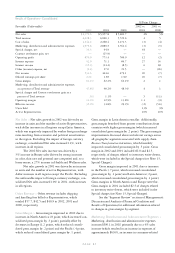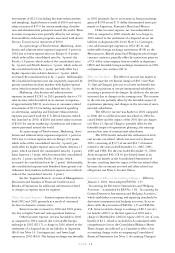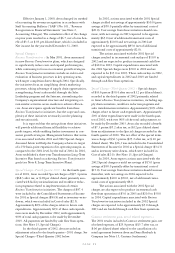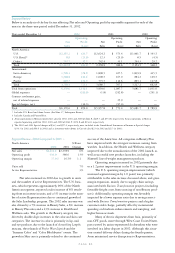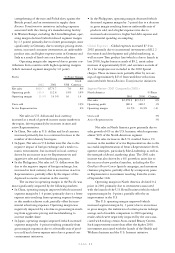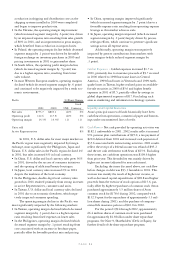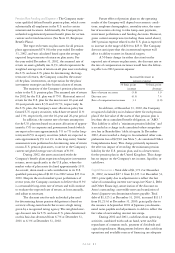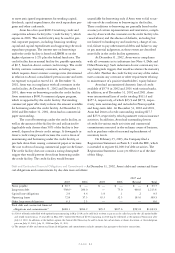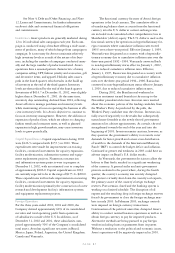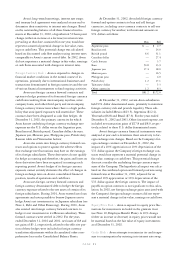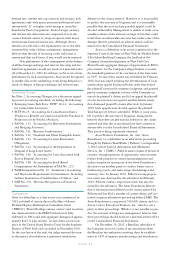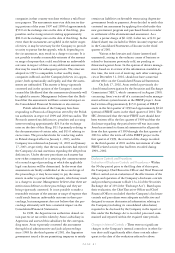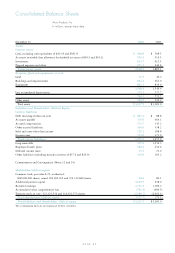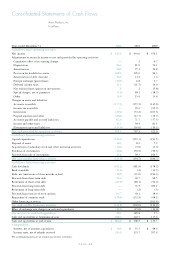Avon 2001 Annual Report Download - page 14
Download and view the complete annual report
Please find page 14 of the 2001 Avon annual report below. You can navigate through the pages in the report by either clicking on the pages listed below, or by using the keyword search tool below to find specific information within the annual report.
PAGE 38
Argentina’s economic activity was severely
depressed during 2002. This resulted from the massive
currency devaluation in early 2002 when the government
allowed the peso to float freely after being pegged to the
U.S. dollar for over 10 years. The situation improved
during the second half of the year as the economy began to
stabilize. In early 2003, the IMF extended a new loan to
help Argentina avoid default on a maturing obligation.
This was intended to give the country time to hold its
2003 presidential elections and allow the new government
to establish policies to begin to correct the country’s eco-
nomic problems. Although the currency has stabilized,
there is a continuing risk of further peso weakness as
Argentina deals with its economic problems.
Avon’s diversified global portfolio of businesses has
demonstrated that the effects of weak economies and cur-
rency fluctuations in certain countries may be offset by
strong results in others. Fluctuations in the value of foreign
currencies cause U.S. dollar-translated amounts to change
in comparison with previous periods. Accordingly, Avon
cannot project the possible effect of such fluctuations upon
translated amounts or future earnings. This is due to the
large number of currencies, intercompany transactions,
hedging-related activities entered into in an attempt to
minimize certain effects of exchange rate changes where
economically feasible, and the fact that all foreign curren-
cies do not react in the same manner against the U.S. dollar.
Some foreign subsidiaries rely primarily on borrow-
ings from local commercial banks to fund working capital
needs created by their highly seasonal sales pattern. At
December 31, 2002, the total indebtedness of foreign sub-
sidiaries to third parties was $72.8. In addition, from time
to time, when appropriate, given tax and other considera-
tions, Avon will finance subsidiary working capital needs.
During 2002, Avon’s foreign subsidiaries remitted,
net of taxes, $397.3 in dividends and royalties. This sum
is a substantial portion of the 2002 consolidated net earn-
ings of those subsidiaries.
In Europe, a single currency called the euro was
introduced on January 1, 1999 to replace the separate cur-
rencies of 12 of the 15 member countries of the European
Union and did replace such currencies on January 1, 2002.
Avon operating subsidiaries affected by the euro conver-
sion have addressed issues raised by the euro currency con-
version, including the need to adapt information
technology systems, business processes and equipment to
accommodate euro-denominated transactions, the impact
of one common currency on pricing and recalculating cur-
rency risk. The system and equipment conversion costs
were not material.
Risk Management Strategies and Market Rate
Sensitive Instruments
Derivative Instruments > As discussed above, Avon operates
globally, with manufacturing and distribution facilities
in various locations around the world. Avon may reduce
its exposure to fluctuations in earnings and cash flows
associated with changes in interest rates and foreign
exchange rates by creating offsetting positions through the
use of derivative financial instruments. Since Avon uses
foreign currency rate-sensitive and interest rate-sensitive
instruments to hedge a certain portion of its existing and
forecasted transactions, Avon expects that any loss in value
for the hedge instruments generally would be offset by
increases in the value of the underlying transactions.
Avon does not enter into derivative financial instru-
ments for trading purposes, nor is Avon a party to lever-
aged derivatives. The master agreements governing Avon’s
derivative contracts generally contain standard provisions
that could trigger early termination of the contracts in cer-
tain circumstances, including if Avon were to merge with
another entity and the creditworthiness of the surviving
entity were to be “materially weaker” than that of Avon
prior to the merger. In certain of these master agreements,
“materially weaker” has been defined by reference to spe-
cific credit ratings.
Interest Rate Risk > Avon’s long-term borrowings, which
are primarily on a fixed-rate basis, are subject to interest
rate risk. Avon uses interest rate swaps to hedge interest
rate risk on its fixed-rate debt. In addition, Avon may
periodically employ interest rate caps and forward interest
rate agreements to reduce exposure, if any, to increases in
variable interest rates.
At December 31, 2002, Avon held interest rate
swap agreements that effectively convert fixed interest on
$600.0 of Avon’s outstanding debt to a variable interest
rate based on LIBOR, as follows:
Notional
Amount Maturity Date Related Outstanding Debt
$100.0 November 2004 $200.0, 6.90% Notes, due 2004
100.0 November 2004 200.0, 6.90% Notes, due 2004
100.0 August 2007 100.0, 6.55% Notes, due 2007
150.0 November 2009 300.0, 7.15% Notes, due 2009
150.0 November 2009* 300.0, 7.15% Notes, due 2009
*This interest rate swap agreement requires Avon to post collateral in
certain circumstances if Avon’s credit rating drops below BBB.
At December 31, 2002, Avon held a treasury lock
agreement with a notional amount of $100.0 that expires
in May 2003 and is used to hedge the exposure to a possi-
ble rise in interest rates prior to the anticipated issuance
of debt in connection with the exercise of the put/call
option associated with the $100.0 of bonds maturing in
May 2018. The agreement will be settled at the time the
new debt is expected to be issued. Upon settlement of
the agreement, the realized gain or loss to be received or
paid by Avon will be amortized as interest expense over
the life of the new debt. Avon has designated the treasury
lock agreement as a cash flow hedge. For the year ended
December 31, 2002, the treasury lock agreement was
determined to be highly effective, and no ineffective por-
tion was recognized in earnings.


